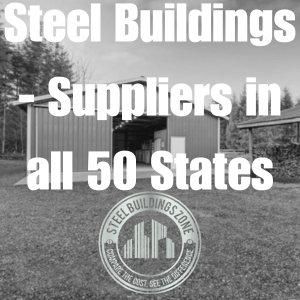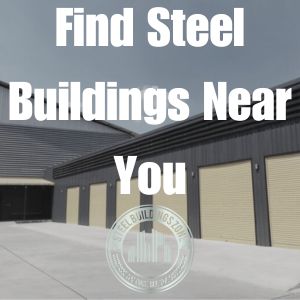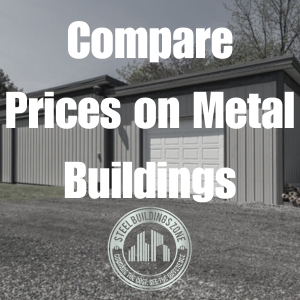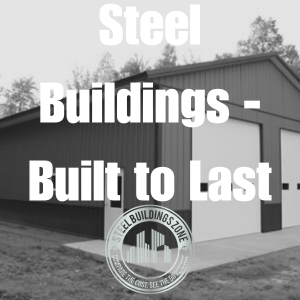
Building for Growth: Expanding with Metal Buildings
Every business owner knows that growth is not just about numbers or profit margins. It’s about envisioning the future, adapting to change, and ensuring that infrastructure keeps pace with ambitions. In the world of structures and facilities, metal buildings stand out as a remarkably flexible option for businesses on the move. This article explores how metal structures can be a strategic choice for companies looking to expand and adapt in today’s fast-paced business environment.
A Solid Foundation for Expansion
When a business starts to grow, it often encounters the need for more space. Whether it’s a retail store seeing more foot traffic, a manufacturer increasing production lines, or a logistics company needing more warehouse space, the requirement for more square footage is inevitable.
Traditional construction methods can be time-consuming and might disrupt business operations. In contrast, metal buildings, with their prefabricated parts and streamlined construction process, can significantly reduce build times. This speed ensures that businesses can continue to operate with minimal disruption and can scale their infrastructure in line with their growth trajectory.
The Versatile Solution for Business Expansion
As businesses flourish and develop, the physical space in which they operate must adapt. Expansion isn’t merely about adding more room; it’s about creating spaces that are functional, durable, and tailor-made for the evolving requirements of the company. Metal buildings shine in this context, offering a plethora of solutions catering to varied business needs. Let’s delve into some specific ways businesses can use metal buildings to seamlessly expand their operational spaces.

Warehouses
One of the primary challenges growing businesses face, especially in the retail, manufacturing, and e-commerce sectors, is storage. As inventory grows, a robust and efficient storage system becomes paramount.
Metal warehouses come to the rescue by providing a cost-effective solution. These structures are designed to maximize space, allowing for efficient racking and shelving systems. Their clear-span design eliminates the need for intrusive support beams, ensuring optimal space utilization. Additionally, metal buildings can easily accommodate overhead doors, docks, and ventilation systems, making the inflow and outflow of goods seamless.
Workshops
For industries that deal in production, repair, or maintenance, having a dedicated space is vital. A cramped or inadequate workshop can hamper productivity and, more importantly, can be a safety concern.
Metal workshops are an excellent choice for such businesses. They can be customized to fit specific machinery, equipment, and workflow designs. With options for enhanced lighting, insulation, and electrical fittings, these workshops can be tailor-made to suit industry-specific requirements. The durability of metal also ensures that these spaces can handle heavy machinery, high temperatures, and other rigorous workshop conditions.
Commercial Buildings
Retailers, service providers, and entrepreneurs need commercial spaces that resonate with their brand identity and can cater to their clientele effectively. Traditional brick-and-mortar structures can sometimes be restrictive in terms of design modifications and expansions.
Metal commercial buildings offer a fresh perspective. Whether it’s a showroom, an office, or a service center, these buildings allow for design flexibility. Want large open spaces for product displays? Or segmented areas for different office departments? Metal structures can be molded to fit these visions. Their exterior can also be customized to create a modern, traditional, or industrial look, aligning with the brand’s aesthetic. Moreover, as the business grows, adding more space or altering the existing layout becomes a hassle-free process.
Additional Facilities
Apart from the core operational spaces, businesses often require additional facilities like parking garages, recreational areas for employees, or even customer lounges. Metal structures can be designed to cater to these needs as well. Given their modularity, it’s even possible to add these structures to existing premises with minimal disruption to the daily business routine.
When it comes to expansion, metal buildings are akin to a Swiss army knife—versatile, durable, and efficient. They allow businesses to think beyond the conventional and design spaces that align with their growth trajectories. Whether it’s storing products, manufacturing goods, or showcasing them, metal structures provide the canvas on which businesses can paint their growth stories.

Modular and Adaptable Designs
One of the standout features of metal buildings is their inherent modularity. As businesses evolve, so too can their structures. Need an additional office space or a larger showroom? Metal constructions can be easily extended, often without the need to tear down existing walls or make significant structural alterations. This modular nature means businesses can adapt their premises in real time as their needs change.
- Defining Modularity in Metal Buildings: At its core, modularity in metal buildings is about creating structures in sections or modules that can be easily connected, rearranged, or expanded upon. Think of it like building blocks. Each block, or module, is pre-engineered to fit seamlessly with others, allowing for endless configurations.
- Adaptability is the Name of the Game: One of the standout features of modular metal buildings is their adaptability. As a business evolves, so too can its physical space. Need to add an assembly line? No problem. Want to incorporate a new customer service area? It can be done with ease. This kind of adaptability ensures that businesses aren’t held back by the limitations of their physical space.
- Cost-Effective Scalability: Expanding a traditional building can be a costly endeavor, often requiring significant architectural input, prolonged construction times, and considerable disruption to business operations. With modular metal buildings, scalability becomes cost-effective and efficient. Since modules are pre-engineered, adding to an existing structure is straightforward. This minimizes downtime and ensures businesses can continue operating with minimal interruption.
- Tailored Solutions for Every Need: The beauty of modularity lies in its ability to cater to specific business requirements. From open spaces conducive to collaborative environments to segmented areas for specific operations, the possibilities are vast. Whether a business needs high ceilings for equipment or insulated walls for controlled environments, modular metal buildings can be tailored to meet these exact specifications.
- Sustainability and Eco-Friendliness: In today’s environmentally conscious world, businesses are constantly seeking ways to reduce their carbon footprint. Modular metal buildings are inherently eco-friendly. Since they’re manufactured off-site, there’s a reduction in construction waste. Furthermore, these structures are often made from recycled materials and can be recycled at the end of their lifecycle. Their modularity also means that instead of tearing down and rebuilding, businesses can simply reconfigure, reducing the environmental impact further.
- Future-Proofing with Modularity: No one can predict the future, but with modular metal buildings, businesses can be prepared for it. As industries evolve and technologies advance, having a malleable space can be a game-changer. Instead of viewing a building as a static entity, modularity allows businesses to see it as a dynamic space, ready to evolve in tandem with the business.
Metal building modularity is more than just a construction approach; it’s a business strategy. In a world where agility and adaptability are key, having a physical space that can mirror a company’s evolution is invaluable. By embracing modularity, businesses position themselves not just for the challenges of today but for the opportunities of tomorrow.

Are Metal Buildings Financially Feasible?
Expansion often comes with hefty price tags. However, metal buildings, due to their prefab nature, often present a more cost-effective solution compared to brick and mortar constructions. The savings aren’t just in the initial construction either. Metal buildings typically have lower maintenance costs, are more resistant to pests, and have longer lifespans. Over time, these savings can be channeled back into the business, fueling further growth.
The Economics of Expanding with Metal Buildings
Expanding a business infrastructure, whether it’s due to increased demand or a vision for the future, is a significant endeavor. Often, the expansion decision boils down to a critical factor: cost. Metal buildings, with their versatility and durability, present a compelling case from an economic standpoint. Here’s a deeper look into why expanding with metal buildings can be a financially savvy move for businesses.
Upfront Costs: Comparing Apples to Oranges
- Traditional Construction: Building with traditional materials like wood, brick, or concrete comes with its set of upfront costs. The price of these materials often fluctuates based on market demand, regional availability, and transport costs. Additionally, specialized labor, like brick masons or carpenters, can drive up costs.
- Metal Buildings: On the other hand, the costs associated with metal structures are generally more stable. Steel, a primary component of metal buildings, has a global market, making its prices more consistent. The components of metal buildings are also manufactured in controlled environments, ensuring efficiency and reducing waste. This streamlined process translates to cost savings that can be passed onto the customer.
Speed of Construction: Time is Money
Speed is a direct contributor to cost. The faster a building goes up, the quicker it can be put to use, yielding a return on investment.
- Traditional Construction: Conventional buildings require sequential construction. Each step depends on the completion of the previous one, extending the construction timeline.
- Metal Buildings: These structures, due to their prefabricated nature, can be erected much faster. With components made to fit together seamlessly, construction crews can work efficiently, cutting down on labor hours and associated costs.
Flexibility and Future Costs
One of the often-overlooked aspects of building expansion is the cost associated with future modifications.
- Traditional Construction: Making changes or expansions to conventionally constructed buildings can be pricey. Often, it requires significant demolition, disposal of waste, and rebuilding.
- Metal Buildings: Given their modular nature, metal buildings can be more easily modified. Whether it’s adding additional sections or reconfiguring the existing layout, the intrinsic design of metal structures allows for more straightforward alterations. This adaptability can result in significant cost savings in the long run.
Maintenance and Longevity
Over the lifespan of a building, maintenance can represent a substantial cost.
- Traditional Construction: Wood can rot or become infested with pests. Brick and mortar can crack and require repointing. Such maintenance not only costs money but can also disrupt business operations.
- Metal Buildings: Steel structures are inherently resistant to many of the issues that plague traditional buildings. They don’t rot, are pest-resistant, and can withstand severe weather conditions. A galvanized steel frame also offers protection against rust. The durability and durable grades of steel translate to fewer maintenance needs and associated costs.

Environmental Costs
While not always a direct monetary cost, the environmental impact of construction can have long-term economic implications, especially with increasing regulatory focus on sustainability.
- Traditional Construction: The waste generated from conventional construction methods can be significant.
- Metal Buildings: As previously mentioned, these structures often involve less waste due to off-site manufacturing. Moreover, many metal buildings utilize recycled materials, further reducing their environmental footprint.
When considering the economics of expanding with metal buildings, it’s essential to look beyond just the initial price tag. Factors like construction speed, future flexibility, maintenance needs, and environmental impact all play a role in the total cost of ownership. With their myriad of advantages, metal buildings offer a cost-effective solution for businesses looking to expand their horizons.
Eco-Friendly Growth
Today, more than ever, businesses are aware of their environmental footprint. Metal buildings have a strong card to play in this regard. Many metal structures are made from recycled materials and are themselves 100% recyclable at the end of their lifespan. Moreover, they offer excellent insulation options, ensuring energy efficiency and reducing operational costs. By opting for metal constructions, businesses are not only thinking of their growth but are also making an environmentally responsible choice.
Prepared for the Unexpected
In a rapidly changing world, businesses face various challenges, from economic downturns to unforeseen natural disasters. Metal buildings, known for their durability and strength, can withstand extreme weather conditions better than many traditional structures. This resilience ensures that businesses have one less thing to worry about and can focus on their growth journey.
The path to growth is paved with decisions that have long-term implications. Choosing the right infrastructure is one such critical decision. Metal buildings, with their adaptability, durability, and cost-effectiveness, offer businesses a reliable partner in their growth journey. As the business landscape evolves and companies look for ways to stay agile and resilient, metal structures are poised to play a pivotal role in building for the future. Should you find yourself with a need for metal building guidance, we at Steel Building Zone are here to help!
COMPARE QUOTES
Leave a Reply